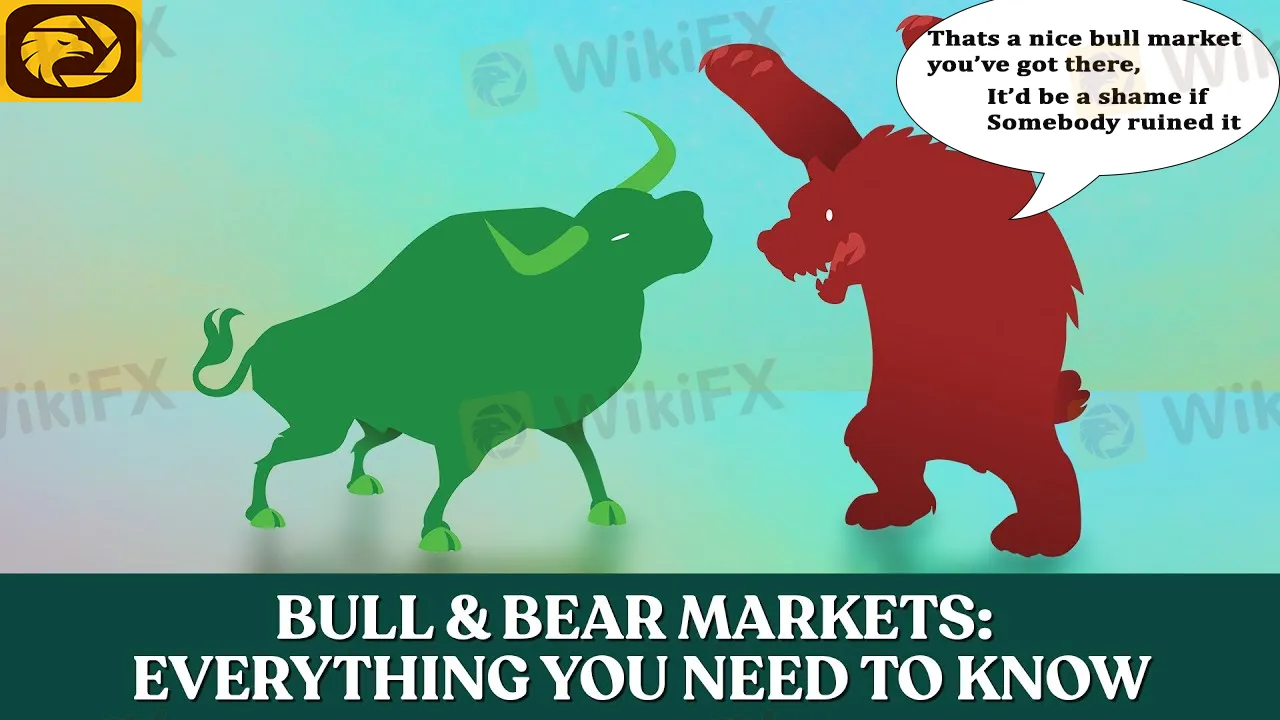简体中文
繁體中文
English
Pусский
日本語
ภาษาไทย
Tiếng Việt
Bahasa Indonesia
Español
हिन्दी
Filippiiniläinen
Français
Deutsch
Português
Türkçe
한국어
العربية
An Overview of Bull and Bear Markets
Abstract:The terms are simple but their causes are incredibly complex

In the investing world, the terms “bull” and “bear” are frequently used to refer to market conditions. These terms describe how stock markets are doing in general—that is, whether they are appreciating or depreciating in value. And as an investor, the direction of the market is a major force that has a huge impact on your portfolio. So, it's important to understand how each of these market conditions may impact your investments.

Bull Market vs. Bear Market

A bull market is a market that is on the rise and where the conditions of the economy are generally favorable. A bear market exists in an economy that is receding and where most stocks are declining in value. Because the financial markets are greatly influenced by investors' attitudes, these terms also denote how investors feel about the market and the ensuing economic trends.
A bull market is typified by a sustained increase in prices. In the case of equity markets, a bull market denotes a rise in the prices of companies' shares. In such times, investors often have faith that the uptrend will continue over the long term. In this scenario, the country's economy is typically strong and employment levels are high.
By contrast, a bear market is one that is in decline. A market is usually not considered a true “bear” market unless it has fallen 20% or more from recent highs. In a bear market, share prices are continuously dropping. This results in a downward trend that investors believe will continue; this belief, in turn, perpetuates the downward spiral. During a bear market, the economy slows down and unemployment rises as companies begin laying off workers.

Characteristics of Bull and Bear Markets
Although a bull market or a bear market condition is marked by the direction of stock prices, there are some accompanying characteristics that investors should be aware of.
Supply and Demand for Securities
In a bull market, there is strong demand and weak supply for securities. In other words, many investors wish to buy securities but few are willing to sell them. As a result, share prices will rise as investors compete to obtain available equity.
In a bear market, the opposite is true: more people are looking to sell than buy. The demand is significantly lower than supply and, as a result, share prices drop.
Investor Psychology
Because the market's behavior is impacted and determined by how individuals perceive and react to its behavior, investor psychology and sentiment affect whether the market will rise or fall. Stock market performance and investor psychology are mutually dependent. In a bull market, investors willingly participate in the hope of obtaining a profit.
During a bear market, market sentiment is negative; investors begin to move their money out of equities and into fixed-income securities as they wait for a positive move in the stock market. In sum, the decline in stock market prices shakes investor confidence. This causes investors to keep their money out of the market, which, in turn, causes a general price decline as outflow increases.
Change in Economic Activity
Because the businesses whose stocks are trading on the exchanges are participants in the greater economy, the stock market and the economy are strongly linked.
A bear market is associated with a weak economy. Most businesses are unable to record huge profits because consumers are not spending nearly enough. This decline in profits directly affects the way the market values stocks.
In a bull market, the reverse occurs. People have more money to spend and are willing to spend it. This drives and strengthens the economy.
Gauging Market Changes
The key determinant of whether the market is bull or bear is not just the market's knee-jerk reaction to a particular event, but how it's performing over the long term. Small movements only represent a short-term trend or a market correction. Whether or not there is going to be a bull market or a bear market can only be determined over a longer time period.
However, not all long movements in the market can be characterized as bull or bear. Sometimes a market may go through a period of stagnation as it tries to find direction. In this case, a series of upward and downward movements would actually cancel-out gains and losses resulting in a flat market trend.
What to Do in Each Market
In a bull market, the ideal thing for an investor to do is to take advantage of rising prices by buying stocks early in the trend (if possible) and then selling them when they have reached their peak.
During the bull market, any losses should be minor and temporary; an investor can typically actively and confidently invest in more equity with a higher probability of making a return.
In a bear market, however, the chance of losses is greater because prices are continually losing value and the end is often not in sight. Even if you do decide to invest with the hope of an upturn, you are likely to take a loss before any turnaround occurs. Thus, most of the profitability can be found in short selling or safer investments, such as fixed-income securities.
An investor may also turn to defensive stocks, whose performance is only minimally impacted by changing trends in the market. Therefore, defensive stocks are stable in both economic gloom and boom cycles. These are industries such as utilities, which are often owned by the government. They are necessities that people buy regardless of economic conditions.
In addition, investors may benefit from taking a short position in a bear market and profiting from falling prices. There are several ways to achieve this including short selling, buying inverse exchange-traded funds (ETFs), or buying put options.
The Bottom Line
Both bear and bull markets will have a large influence on your investments, so it's a good idea to take some time to determine what the market is doing when making an investment decision. Remember that over the long term, the stock market has always posted a positive return.

Disclaimer:
The views in this article only represent the author's personal views, and do not constitute investment advice on this platform. This platform does not guarantee the accuracy, completeness and timeliness of the information in the article, and will not be liable for any loss caused by the use of or reliance on the information in the article.
Read more

Fidelity Exposed: Traders Complain About Withdrawal Denials, Frozen Accounts & Platform Glitches
Does Fidelity Investments prevent you from accessing funds despite numerous assurances on your requests? Do you witness an account freeze by the US-based forex broker every time you request withdrawal access? Do you struggle with an unstable trading platform here? Is the slow Fidelity customer service making you face forced liquidation? These issues haunt traders, with many of them voicing their frustration on several broker review platforms such as WikiFX. In this Fidelity review article, we have shared quite a few complaints for you to look at. Read on!

Exposing The Trading Pit: Traders Blame the Broker for Unfair Withdrawal Denials & Account Blocks
Did you receive contradictory emails from The Trading Pit, with one approving payout and another rejecting it, citing trading rule violations? Did you purchase multiple trading accounts but receive a payout on only one of them? Did The Trading Pit prop firm refund you for the remaining accounts without clear reasoning? Did you face account bans despite using limited margins and keeping investment risks to a minimum? These are some raging complaints found under The Trading Pit review. We will share some of these complaints in this article. Take a look.

M&G Review: Traders Report Fund Scams, Misleading Market Info & False Return Promises
Applying for multiple withdrawals at M&G Investments but not getting it into your bank account? Do you see the uncredited withdrawal funds out of your forex trading account on the M&G login? Does the customer support service fail to address this trading issue? Does the misleading market information provided on this forex broker’s trading platform make you lose all your invested capital? Were you lured into investing under the promise of guaranteed forex returns? These issues have become highly common for traders at M&G Investments. In this M&G review article, we have echoed investor sentiments through their complaint screenshots. Take a look!

INZO Broker MT5 Review 2025: A Trader's Guide to Features, Fees and Risks
INZO is a foreign exchange (Forex) and Contracts for Difference (CFD) brokerage company that started working in 2021. The company is registered in Saint Vincent and the Grenadines and regulated offshore. It focuses on serving clients around the world by giving them access to popular trading platforms, especially MetaTrader 5 (MT5) and cTrader. The company offers different types of trading instruments, from currency pairs to cryptocurrencies. It aims to help both new and experienced traders. Read on to know more about it.
WikiFX Broker
Latest News
Forex Expert Recruitment Event – Sharing Insights, Building Rewards
Admirals Cancels UAE License as Part of Global Restructuring
Moomoo Singapore Opens Investor Boutiques to Strengthen Community
OmegaPro Review: Traders Flood Comment Sections with Withdrawal Denials & Scam Complaints
An Unbiased Review of INZO Broker for Indian Traders: What You Must Know
BotBro’s “30% Return” Scheme Raises New Red Flags Amid Ongoing Fraud Allegations
The 5%ers Review: Is it a Scam or Legit? Find Out from These Trader Comments
WikiEXPO Dubai 2025 Concludes Successfully — Shaping a Transparent, Innovative Future
2 Malaysians Arrested in $1 Million Gold Scam Impersonating Singapore Officials
Is FXPesa Regulated? Real User Reviews & Regulation Check
Currency Calculator



